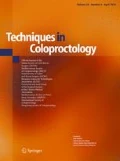Abstract
Background
Brachial plexopathy may be caused by malpositioning during surgery when the body’s protective mechanism is lost under general anaesthesia. It is the second commonest nerve injury reported in the anaesthetized patient. The exact incidence in colorectal surgery is unclear but there have been numerous cases reported of brachial plexopathy as an adverse event following colorectal surgery. Although it is widely believed that these injuries are preventable by paying special attention to vulnerable areas during patient positioning and by careful intraoperative monitoring, it appears that nerve injury may still occur.
Methods
Patients with post-operative brachial plexopathy in our prospectively kept database were identified. The patient notes were reviewed and documented.
Results
In our series, five cases of brachial plexopathy were still observed despite careful precautions taken to prevent nerve injury. The proposed mechanism of nerve injury in our series is most likely due to nerve stretch. All symptoms resolved with the longest taking 7 months before resolution. During this period from 2005 to 2010 our unit performed 548 laparoscopic colorectal resections. The relative incidence of brachial plexopathy in our series is approximately 1 %.
Conclusion
We recommend certain precautionary steps to follow, as well as predisposing and perioperative factors to be aware of when anticipating a laparoscopic colorectal procedure. These may all contribute to minimising brachial plexopathy which most likely is under-reported in laparoscopic colorectal surgery but is a preventable morbidity to the patient.
Similar content being viewed by others
References
Cheney FW, Domino KB, Caplan RA, Posner KL (1999) Nerve injury associated with anaesthesia: a closed claim analysis. Anaesthesiology 90:1062–1069
Kretschmer T, Heinen CW, Antoniadis G, Richter HP, König RW (2009) Iatrogenic nerve injuries. Neurosurg Clin N Am 20:73–90
Romanowski L, Reich H, McGlynn F, Adelson MD, Taylor PJ (1993) Brachial plexus neuropathies after advanced laparoscopic surgery. Fertil Steril 60:729–732
Brill S, Walfisch S (2005) Brachial plexus injury as a complication after colorectal surgery. Tech Coloproctol 9:139–141
Agostini J, Goasguen N, Mosnier H (2010) Patient positioning in laparoscopic surgery: tricks and tips. J Visc Surg 147:E227–E232
Winfree CJ, Kline DG (2005) Intraoperative positioning nerve injury. Surg Neurol 63:5–18
Chong AY, Clark CE, Dimitri WR, Lip GY (2003) Brachial plexus injury as an unusual complication of coronary artery bypass graft surgery. Post grad Med J 79:84–86
Kent CD, Cheney FW (2007) A case of bilateral brachial plexus palsy due to shoulder braces. J Clin Anaesth 19:482–484
Chin P, Garth P (2003) Bilateral brachial plexus injury during laparoscopic sigmoid colectomy. ANZ J Surg 73:86–88
Zhang J, Moore AE, Stringer MD (2011) Iatrogenic upper limb nerve injuries: a systematic review. ANZ J Surg 81:227–236
Uribe JS, Kolla J, Omar H et al (2010) Brachial plexus injury following spinal surgery: a review. J Neurosurg Spine 13:552–558
Bradshaw AD, Advincula AP (2010) Postoperative neuropathy in gynaecologic surgery. Obstet Gynecol Clin N Am 37:451–459
Shveicky D, Aseff JN, Iglesia CB (2010) Brachial plexus injury after laparoscopic and robotic surgery. J Minim Invasive Gynecol 17:414–420
Seddon HJ (1943) Three types of nerve injury. Brain 66:237–288
Phong SV, Koh LK (2007) Anaesthesia for robotic-assisted radical prostatectomy: considerations for laparoscopy in the Trendelenburg position. Anaesth Intensive Care 35:281–285
Ben-David B, Stahl S (1997) Prognosis of intraoperative brachial plexus injury: a review of 22 cases. Br J Anaesth 79:440–445
Cooper DE, Jenkins RS, Bready L, Rockwood CA Jr (1988) The prevention of injuries of the brachial plexus secondary to malposition of the patient during surgery. Clin Orthop Relat Res 228:33–41
Kaye A (1991) Classification of nerve injuries, in Essential Neurosurgery. Churchill Livingstone, New York, pp 333–334
Conflict of interest
None.
Author information
Authors and Affiliations
Corresponding author
Rights and permissions
About this article
Cite this article
Eteuati, J., Hiscock, R., Hastie, I. et al. Brachial plexopathy in laparoscopic-assisted rectal surgery: a case series. Tech Coloproctol 17, 293–297 (2013). https://doi.org/10.1007/s10151-012-0920-8
Received:
Accepted:
Published:
Issue Date:
DOI: https://doi.org/10.1007/s10151-012-0920-8




